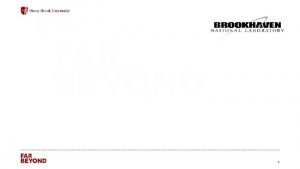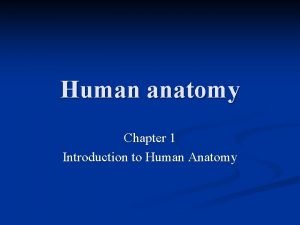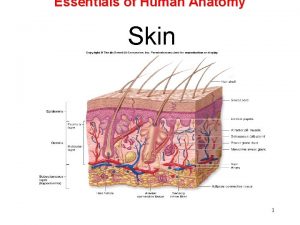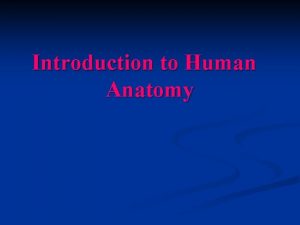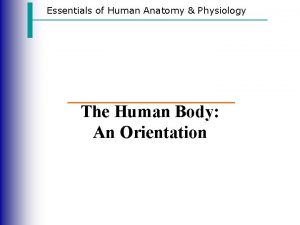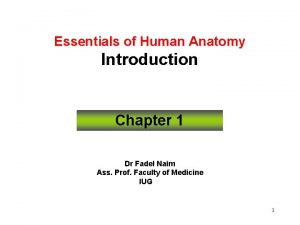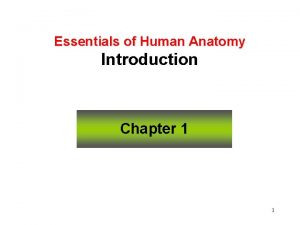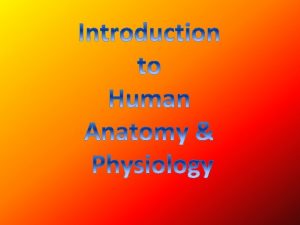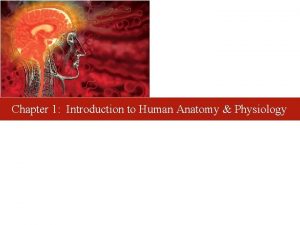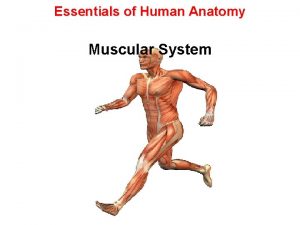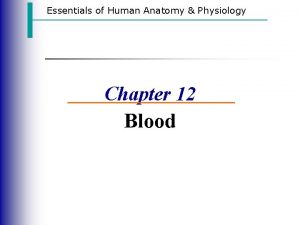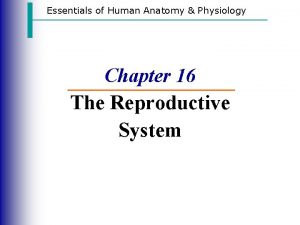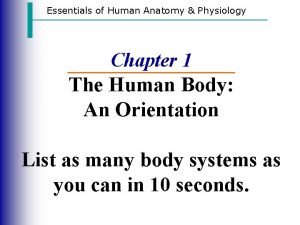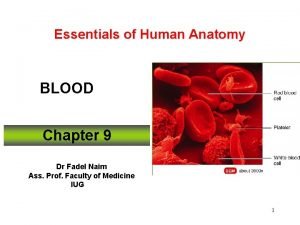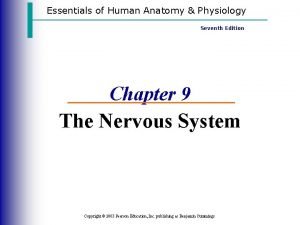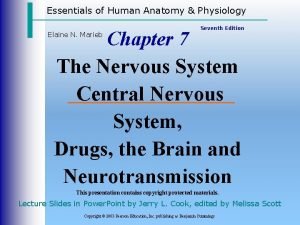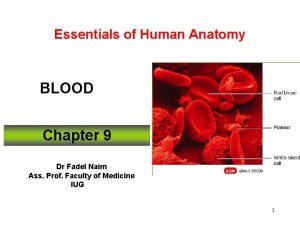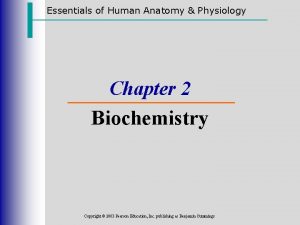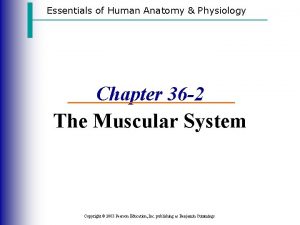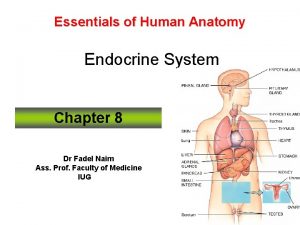Essentials of Human Anatomy Introduction Chapter 1 Dr









































- Slides: 41

Essentials of Human Anatomy Introduction Chapter 1 Dr Fadel Naim Ass. Prof. Faculty of Medicine IUG 1

THE DEFINITION OF ANATOMY • Anatomy – Greek=to cut up, or dissect – The science that deals with the structure of the body • Kinds: – – Gross Anatomy Microscopic Anatomy Developmental Anatomy Comparative Anatomy

Gross Anatomy • Definition: – That which can be seen with the naked eye • Kinds: – Regional: • body studied by area – Systematic: • body studied by system

Microscopic Anatomy • Definition: – That which can be seen with the assisted eye • Kinds: – Cytology: • The study of cells – Histology: • The study of tissues – Organology: • The study of organs

Developmental Anatomy • Definition: – The study of anatomical changes in a life cycle • Kinds: – Embryology: • The study of prenatal development – Postnatal development: • The study of structures after birth

Comparative Anatomy • Definition: – Comparison of structures between organisms • Kinds: – Vertebrate: • Comparison of structures among the vertebrate classes

Physiology v v v The scientific discipline that studies the function of body structures. Structure and function cannot be completely separated. Form is related to function

Levels of Organization Subatomic Particles – electrons, protons, neutrons Atom – hydrogen atom, lithium atom Molecule – water molecule, glucose molecule Macromolecule – protein molecule, DNA molecule Organelle – mitochondrion, Golgi apparatus, nucleus Cell – muscle cell, nerve cell Tissue – simple squamous epithelium, loose connective tissue Organ – skin, femur, heart, kidney Organ System – skeletal system, digestive system Organism - human 8


Integumentary System • Components – Skin – Hair, nails • Function – External covering – Protection – Synthesis of Vitamin D – Location of Sense receptors

Skeletal System • Components – Bones – Joints and adjacent cartilages • Function – – Support Protection Movement Blood cell production (red bone marrow) – Mineral storage (calcium and phosphorus)

Muscular System • Components – Skeletal Muscles – Associated Connective Tissues (tendons) • Function – Locomotion – Manipulation of the environment – Facial expression (communication) – Maintain posture – Produce heat

Circulatory System • Components – Cardiovascular System – Lymphatic System • Function – Transportation of materials Within the body – To and from internal and external environments

Cardiovascular System • Components – Heart – Vessels • Function – Transportation of blood – Blood contains O 2 and CO 2, nutrients, wastes, etc. – Blood composed of plasma and cells

Lymphatic System • Components – Lymphatic Organs (spleen, lymph nodes, thymus, etc. ) – Lymphatic Vessels • Function – Transportation of lymph – Lymph is derived from tissue fluid – Houses white blood cells

Immune System • Components – Immune Organs (red bone marrow, thymus, etc. ) – White blood cells (lymphocytes, macrophages, etc. ) • Function – Defense (Immune response)

Nervous System • Components – Brain, Spinal cord (CNS) – Nerves (PNS), sense receptors • Function – Control system (fast, “hard wired”) – Response to external and internal environments

Endocrine System • Components – Glands that secrete hormones – E. g. : Pituitary, pancreas, thyroid • Function – Control system (slow, “chemical”) – Regulates processes such as growth, reproduction and nutrient use

Respiratory System • Components – Lungs – Tubing ( trachea, bronchus, etc. ) – Larynx (vocal cords) • Function – Exchange of respiratory gases (O 2 and CO 2) between blood and atmosphere – Voice production

Digestive System • Components – Alimentary canal (mouth, pharynx, esophagus, stomach, small intestine, large intestine) – Accessory structures(liver, salivary glands, etc. ) • Function – Break down food into small, absorbable pieces – Between blood and lumen – Eliminate waste

Urinary System • Components – Kidneys, Ureters, Urinary bladder, Urethra • Function – Eliminate waste (nitrogen) from blood – Between blood and external environment – Regulates water, electrolytes, acid/base

Reproductive System • Components – Male Reproductive System – Female Reproductive System • Function – Perpetuation of the species – Hormones influence structure and function – Sexually bimorphic species

Anatomical Terminology v Anatomic position is a specific body position in which an individual stands upright with the feet parallel and flat on the floor. v The head is level, and the eyes look forward toward the observer. v The arms are at either side of the body with the palms facing forward and the thumbs pointing away from the body.

Anatomical Terminology v A plane is an imaginary surface that slices the body into specific sections. v The three major anatomic planes of reference are the coronal, transverse, and sagittal planes.

Sections and Planes A coronal plane, also called a frontal plane, is a vertical plane that divides the body into anterior (front) and posterior (back) parts.

Sections and Planes v A transverse plane, also called a cross-sectional plane or horizontal plane, cuts perpendicularly along the long axis of the body or organ separating it into both superior (upper) and inferior (lower) parts.

Sections and Planes v A sagittal plane or median plane, extends through the body or organ vertically and divides the structure into right and left halves.

Sections and Planes v A sagittal plane in the body midline is a midsagittal plane. v A plane that is parallel to the midsagittal plane, but either to the left or the right of it, is termed a parasagittal (or sagittal) plane. v A minor plane, called the oblique plane, passes through the specimen at an angle.

Directional Terms of the Body v. Directional terms are precise and brief, and for most of them there is a correlative term that means just the opposite.

Relative and Directional Terms of the Body v Relative to front (belly side) or back (back side) of the body : § Anterior = In front of; toward the front surface § Posterior = In back of; toward the back surface § Dorsal =At the back side of the human body § Ventral = At the belly side of the human body

Relative and Directional Terms of the Body v Relative to the head or tail of the body: § Superior = Toward the head or above § Inferior = Toward feet not head § Caudal = At the rear or tail end § Cranial = At the head end

Relative and Directional Terms of the Body v Relative to the midline or center of the body: § Medial = Toward the midline of the body § Lateral = Away from the midline of the body § Deep = On the inside, underneath another structure § Superficial = On the outside

Relative and Directional Terms of the Body v Relative to point of attachment of the appendage: § Proximal = Closest to point of attachment to trunk § Distal = Furthest from point of attachment to trunk

cephalic=head frontal=forehead nasal=nose orbital=eye buccal=cheek oral=mouth cervical=neck mental=chin acromial=shoulder sternal=breast bone axillary=armpit thoracic=chest mammary=breast brachial=arm antecubital=front elbow olecranal=back elbow antebrachial=forea rm popliteal=posterior knee sural=calf carpal=wrist palmar=palm pollex=thumb digital=fingers/toes pubic=genital patellar=anterior knee crural=leg tarsal=ankle hallux=big toe occipital=base of skull vertebral=spinal scapular=shoulder blade dorsum=back lumbar=loin sacral=between hips perineal=between anus and genitalia femoral=thigh calcaneal=heel plantar=sole



Body Cavities: Dorsal • Cranial Cavity – Houses the Brain • Spinal Cavity Vertebral Canal – Houses the Spinal Cord

Body Cavities: Ventral (Lateral View) Thoracic Cavity • Abdominopelvic Cavity (contains the “viscera”) Abdominal Cavity Pelvic Cavity Diaphragm

Abdominal Divisions • Quadrants: 4 – Right Upper Quadrant – Right Lower Quadrant – Left Upper Quadrant – Left Lower Quadrant

Abdominal Divisions • Regions: 9 – – – – – Rt Hypochondriac region Rt Lumbar region Rt Iliac (Inguinal) region Epigastric region Umbilical region Hypogastric (Pubic) region Lt Hypochondriac region Lt Lumbar region Lt Iliac (Inguinal) region

THE END
 Chapter 1 introduction to human anatomy and physiology
Chapter 1 introduction to human anatomy and physiology Anterior posterior distal proximal
Anterior posterior distal proximal Chapter 2 human reproductive anatomy and physiology
Chapter 2 human reproductive anatomy and physiology Game development essentials: an introduction
Game development essentials: an introduction Anterior posterior ventral dorsal
Anterior posterior ventral dorsal 8.3 human needs
8.3 human needs Chapter 8 human needs and human development
Chapter 8 human needs and human development It essentials chapter 8
It essentials chapter 8 5 essentials for a successful ffa chapter
5 essentials for a successful ffa chapter It essentials chapter 9
It essentials chapter 9 Ite chapter 14
Ite chapter 14 It essentials chapter 12
It essentials chapter 12 It essential chapter 11
It essential chapter 11 Business essentials 12th edition chapter 1
Business essentials 12th edition chapter 1 Marketing essentials chapter 38
Marketing essentials chapter 38 Chapter 13 initiating the sale answer key
Chapter 13 initiating the sale answer key Form utility
Form utility It essentials chapter 5
It essentials chapter 5 It essentials chapter 3
It essentials chapter 3 It essentials chapter 11
It essentials chapter 11 Essentials of social media marketing chapter 9 quiz
Essentials of social media marketing chapter 9 quiz It essentials chapter 7
It essentials chapter 7 It essentials chapter 6
It essentials chapter 6 It essentials chapter 5
It essentials chapter 5 It essentials chapter 4
It essentials chapter 4 Math is the foundation of the kitchen and the back office
Math is the foundation of the kitchen and the back office It essentials chapter 2
It essentials chapter 2 It essential chapter 5
It essential chapter 5 Pata cable
Pata cable It essentials chapter 10
It essentials chapter 10 It essentials chapter 10
It essentials chapter 10 Catholic essentials chapter 1 crossword answers
Catholic essentials chapter 1 crossword answers Marketing essentials chapter 2
Marketing essentials chapter 2 It essentials chapter 4
It essentials chapter 4 It essentials chapter 7
It essentials chapter 7 What are the ten essentials of a successful ffa chapter
What are the ten essentials of a successful ffa chapter It essentials chapter 8
It essentials chapter 8 It essentials chapter 6
It essentials chapter 6 _______is considered as moist method of cooking.
_______is considered as moist method of cooking. It essentials chapter 13
It essentials chapter 13 Human resource management chapter 1
Human resource management chapter 1 Human resources management chapter 1
Human resources management chapter 1



































